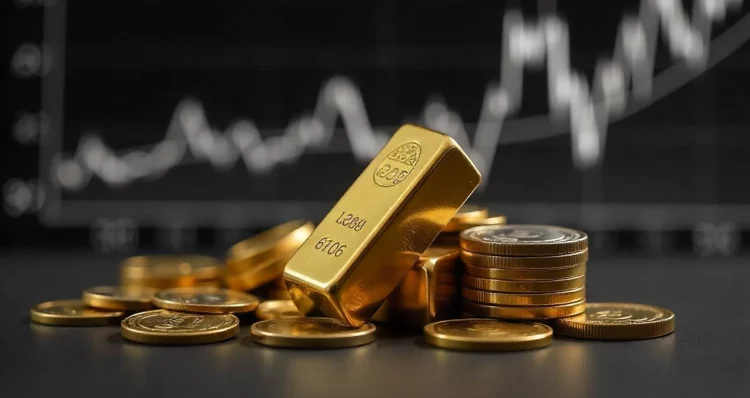Gold has long been regarded as a safe-haven asset, particularly in times of financial crises and economic uncertainty. Throughout history, investors have flocked to gold during periods of market volatility, seeking a store of value that is less susceptible to the whims of paper currencies and stock markets. In this article, we will examine gold’s price movements during major financial crises, explore expert insights into its resilience as a safe-haven asset, discuss how investors can learn from history when investing in gold, and assess the continued relevance of gold in uncertain economic times.
Examining Gold’s Price Movements During Major Financial Crises
To understand gold’s role as a safe-haven asset, it is essential to analyze its performance during key financial crises. From the Great Depression to the 2008 global financial crisis, gold has shown its ability to hold value while other assets have faltered.
1. The Great Depression (1929–1939)
The Great Depression, which began with the stock market crash of 1929, remains one of the most severe economic downturns in modern history. During this time, the global economy contracted, unemployment skyrocketed, and businesses shuttered. As investors panicked, many sought refuge in gold, which was seen as a stable store of wealth.
While the U.S. had a gold standard during this period, the price of gold was fixed at $20.67 per ounce until 1933. However, the U.S. government, under President Franklin D. Roosevelt, took steps to devalue the dollar by increasing the official price of gold to $35 per ounce. This action effectively raised the value of gold, reinforcing its role as a stable asset during times of crisis. Although the global economy remained depressed for years, gold’s price rise during this period demonstrated its resilience as a store of value.
2. The 1970s and the End of the Gold Standard
The end of the Bretton Woods system in 1971, which tied the U.S. dollar to gold, marked the beginning of a new era for the gold market. The U.S. abandoned the gold standard, and the dollar was allowed to float freely. This transition led to increased inflation and currency devaluation, both of which benefited gold.
Throughout the 1970s, gold prices surged, from approximately $35 per ounce in the early part of the decade to a high of over $800 per ounce by 1980. This dramatic increase was driven by high inflation, the oil crisis, and geopolitical tensions, including the Vietnam War and the Arab-Israeli conflict. As a result, gold became a sought-after asset for preserving wealth in a period of economic instability.
3. The 2008 Financial Crisis
The 2008 global financial crisis, triggered by the collapse of Lehman Brothers and the subsequent credit crunch, led to a massive decline in global stock markets and economic uncertainty. During this crisis, gold once again proved its worth as a safe-haven asset. As the stock market plummeted and central banks implemented aggressive monetary policies, such as lowering interest rates and printing money, the value of fiat currencies declined, and investors turned to gold for protection.
From the time of the crisis in 2007 to the peak of gold prices in 2011, gold prices rose from around $600 per ounce to over $1,900 per ounce. This surge in gold prices reflected investor fear and the belief that gold, as a tangible asset, would retain its value in times of economic turmoil. Gold’s performance during the 2008 crisis reinforced its reputation as a reliable asset during periods of financial instability.
4. The COVID-19 Pandemic (2020)
The COVID-19 pandemic, which began in early 2020, triggered one of the most significant global economic disruptions in recent history. As governments implemented lockdowns, markets tumbled, and unemployment soared. In response, central banks around the world enacted massive fiscal stimulus packages, while interest rates were slashed to near zero.
During this crisis, gold once again demonstrated its resilience. As the global economy contracted, investors sought safe-haven assets, pushing the price of gold to a new all-time high of $2,067 per ounce in August 2020. While other markets struggled, gold proved to be a safe store of value, driven by concerns over inflation, currency debasement, and geopolitical uncertainty.

Expert Insights on Gold’s Resilience as a Safe-Haven Asset
Experts have long argued that gold’s role as a safe-haven asset stems from its intrinsic qualities as a tangible, finite, and highly liquid asset. Unlike fiat currencies, which are subject to the policies of central banks and governments, gold is not dependent on the decisions of any one nation or institution. This makes it particularly attractive during times of financial instability.
1. Gold as a Hedge Against Inflation
One of the primary reasons why investors flock to gold during periods of economic uncertainty is its ability to act as a hedge against inflation. Inflation erodes the purchasing power of paper currency, but gold has historically retained its value, even in times of rising prices. During periods of high inflation, gold’s value tends to rise as investors seek to protect their wealth from the diminishing purchasing power of fiat currencies.
For example, during the 1970s, when inflation in the U.S. reached double digits, gold prices skyrocketed as investors sought refuge from the devaluation of the dollar. Similarly, in the wake of the 2008 financial crisis, central banks around the world engaged in unprecedented levels of monetary stimulus, which led to concerns about future inflation and currency devaluation. In both cases, gold performed well as an inflation hedge, and its price increased substantially.
2. Gold as a Store of Value
Another key attribute of gold is its ability to act as a store of value. Unlike paper currencies, which can be printed at will by central banks, the supply of gold is finite. This scarcity gives gold intrinsic value and makes it less susceptible to the erosion of value caused by excessive money printing or government debt.
During periods of economic instability or geopolitical tensions, investors tend to lose confidence in fiat currencies and turn to gold as a reliable store of value. Gold’s physical properties—its durability, divisibility, and portability—further enhance its appeal during crises. As a result, gold has maintained its reputation as a safe-haven asset during turbulent times.
How Investors Can Learn from History When Investing in Gold
History offers valuable lessons for investors looking to add gold to their portfolios. By studying the performance of gold during previous financial crises, investors can gain insight into how gold behaves in different economic environments and how to incorporate gold into their investment strategies.
1. Diversification and Portfolio Protection
Gold is an effective tool for diversifying an investment portfolio. While stocks and bonds are often subject to market volatility, gold tends to perform well during times of economic turmoil. By adding gold to a portfolio, investors can reduce risk and enhance their protection against downturns in other asset classes. Historically, gold has acted as a counterbalance to the negative performance of equities, making it an essential asset for risk management during financial crises.
2. Timing Gold Investments
While gold has demonstrated resilience during financial crises, it is also subject to price fluctuations. Investors should avoid trying to time the market perfectly, but rather consider buying gold when market conditions indicate potential economic stress. For example, during periods of rising inflation, declining real interest rates, or geopolitical instability, gold may present an attractive investment opportunity.
Investors can also use gold as a long-term store of value, holding it through periods of market volatility and using it as a hedge against inflation or currency debasement. Gold is often seen as a “slow burn” investment, meaning it tends to appreciate steadily over time, rather than experiencing rapid gains or losses.
The Continued Relevance of Gold in Uncertain Economic Times
Despite the evolution of financial markets and investment products, gold remains a relevant asset in uncertain economic times. Its historical performance during crises, combined with its qualities as a tangible, scarce asset, ensures that it will continue to be a vital part of investment strategies in the future.
As we face future economic challenges, from geopolitical tensions to financial market disruptions, gold will likely remain a key tool for preserving wealth. Whether as a hedge against inflation, a store of value, or a means of portfolio diversification, gold’s resilience during times of financial crises ensures that it will continue to be an essential part of the global financial system.



































